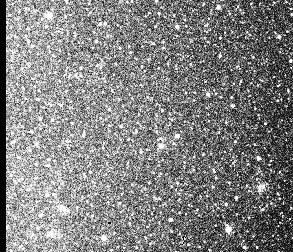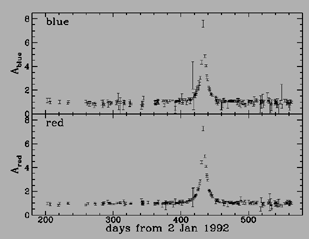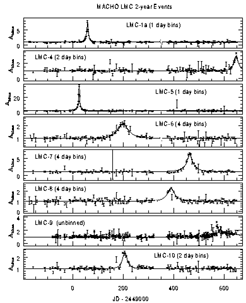


4.6.6. The Microlensing Surveys
Although a formation of the equations which described gravitational lensing is well outside the scope of the book, its fundamentals can be gleaned from a study of Fresnels equations for optical lens. The case of microlensing occurs whenever a point mass passes very close to the line of site of a distant star. This case is different than a standard lens which has a finite area. For microlensing, one can use the point source - point deflector approximation to describe the behavior. There are two important predictions that form the basis for the observational survey described below:
1. As the point deflector crosses the line of site to the point source, there will be a fairly rapid amplification of the light from the point source that the observer sees. This amplification results from the requirement that the flux per solid angle seen by a detector (this can be called the surface brightness) is conserved. The lensing event creates additional optical pathways for the light from the point source to reach the detector. Hence the solid angle has increased and consequently the apparent flux must increase as well. The multiple pathways arise due to general relativistic effects associated with the sudden change in geometry of spacetime between the source and the observer. Without the point deflector, spacetime is flat between the source and the observer. The amplification factor depends on the degree of curvature and hence on the point deflector mass as well as the degree of alignment between the point source and the detector. For a reasonable range of baryonic point deflector candidates and degrees of alignment, amplification factors of 1-100 are expected.
2. Gravitational lensing is achromatic. There is no equivalent to the index of refraction for a normal lens as the behavior of light passing through curved space time is independent of its wavelength. This is the unique signature of gravitational lensing as the cause of the variability of the light output of a distant star. Intrinsic stellar variability (novae, binary stars, pulsating stars) always shows wavelength dependent behavior.
If a significant fraction of the dark matter in the halo of our galaxy
is composed of objects like brown dwarfs or planets then there will be
occasional amplification of the light from extragalactic stars by
the microlensing effect just described. These microlensing events,
however, are extremely rare. Estimates suggest an optical depth to
lensing events of order 10-5 - 10-6. Hence to see a few
events would require imaging a background field of stars that contained
 one million stars. Two such
lines of site are available to
observations done in the Southern Hemisphere namely, the
Large Magellanic Cloud and the Galactic Bulge. Out
of this possibility was
borne the MACHO project.
one million stars. Two such
lines of site are available to
observations done in the Southern Hemisphere namely, the
Large Magellanic Cloud and the Galactic Bulge. Out
of this possibility was
borne the MACHO project.
The MACHO Project is a collaboration between scientists at the Mt. Stromlo and Siding Spring Observatories and the Center for Particle Astrophysics run jointly by the University of California and the Lawrence Livermore National Laboratory. The project leadership is provided by Charles Alcock, a physicist who works at LLNL. This collaboration represents the first successful union of astronomers and particle physicists in a quest to unravel the profound cosmological challenge posed by the dark matter problem. Using a 50-inch telescope and a stunningly clever and efficient detector system, the team acquires several Gbytes of data per night on the photometric brightnesses of stars in LMC and Bulge fields. An example LMC field containing about 1 million stars down to v = 22 mag is shown in Figure 4-7. To date approximately 8 million stars have been observed in two colors in the LMC fields and 10 million in the bulge fields. While there is much photometric variability of stars in these fields due to instrumental, atmospheric and intrinsic stellar variability, the unique signature of a lens event is its achromicity. Thus, the two color (blue and red) observations are the crucial component of the survey design.

|
Figure 4-7: Example image ofr a MACHO field in the LMC that contains approximately one million stars. |
The system has been on the air since January 1992 and despite the enormous
amount of data that requires reduction, very likely lensing events
have been identified. Figure 4-8 shows what an
event looks like as
a plot of light output over time. Clearly in both the red and the blue
channels the light curve is the same. conforming to the expected
signature of
a microlensing event. To date, there have been 8 candidate lens events
towards the LMC and  60
toward the Galactic Bulge. Figure 4-9 shows
the 8 LMC lensing events (from Sutherlin et al. 1996).
As the line of sight
to the Galactic Bulge passes through much more of the Galaxy than the
line of sight to the LMC, this large difference in lensing events is
to be expected. In the case of the bulge, the lensing could be occurring
from point deflectors located either in the solar neighborhood, the
thick disk, the halo or the bulge itself. For the case of the LMC,
it is most likely that the point deflectors are members of the halo
population.
60
toward the Galactic Bulge. Figure 4-9 shows
the 8 LMC lensing events (from Sutherlin et al. 1996).
As the line of sight
to the Galactic Bulge passes through much more of the Galaxy than the
line of sight to the LMC, this large difference in lensing events is
to be expected. In the case of the bulge, the lensing could be occurring
from point deflectors located either in the solar neighborhood, the
thick disk, the halo or the bulge itself. For the case of the LMC,
it is most likely that the point deflectors are members of the halo
population.

|
Figure 4-8: Signature of a gravitational lens amplification of starlight. The degree of amplificatoin and the shape of the light curve is identical in the red and blue filters. |

|
Figure 4-9: ummary of the 8 MACHO events observed in the direction of the LMC. Data taken from Sutherland et al. (1996). A wide range of amplification factors is evident. |
The relevant cosmological question to ask is what are the range of point deflector masses that are consistent with the observations? The answer to this is non-trivial as a full understanding of the detection efficiency must be achieved. A convenient parameterization of the microlensing timescale is (see Alcock et al. 1996)

| (28) |
Thus a Jupiter mass object will have a microlensing timescale
of 4 days. If it is cloudy at the telescope for 4 days in a row,
the sensitivity of the experiment to this lensing event is pretty low.
Thus the survey, due to unavoidable circumstances, is not sensitive
to short duration events. Similarly, the survey
is not sensitive to long duration ( 200 days) events and hence
point deflector masses larger than 3
M
200 days) events and hence
point deflector masses larger than 3
M . While the efficiency
of the MACHO experiment is still a matter of some debate,
a calibration using Monte Carlo techniques by Alcock et al. (1995)
show that greater than 10% efficiency is achieved for lensing timescales
of 10 - 200 days. The peak efficiency is 30% in the range 50 - 100
days. These efficiencies are for cases where the amplification factor
is larger than 1.35. However, since the number of lensing events
increases with decreasing lensing mass, even efficiencies less than 10%
at the low mass end contain information if no short duration event
is ever observed.
. While the efficiency
of the MACHO experiment is still a matter of some debate,
a calibration using Monte Carlo techniques by Alcock et al. (1995)
show that greater than 10% efficiency is achieved for lensing timescales
of 10 - 200 days. The peak efficiency is 30% in the range 50 - 100
days. These efficiencies are for cases where the amplification factor
is larger than 1.35. However, since the number of lensing events
increases with decreasing lensing mass, even efficiencies less than 10%
at the low mass end contain information if no short duration event
is ever observed.
The recent analysis of two years worth of MACHO data (Sutherlin et al. 1996)
in the LMC direction is quite encouraging. Eight
unambiguous lensing events
were detected and the more events there are, the more constraining power the
method has. For instance,
the 3 events that were seen in the first years worth of data
data are consistent with lensing
masses in the range 0.02 - 0.17
M and the fraction of
halo mass
which could be in this form ranges from 6 - 53% (see Alcock et al. 1996).
Much more data will be needed to distinguish
between lensing caused by low mass main sequence stars
versus true brown dwarf objects. It is also
worth noting that analysis of the microlensing events that happen
towards the Galactic Bulge are providing some indication that our
models for the thin disk, thick disk and halo might be incorrect.
and the fraction of
halo mass
which could be in this form ranges from 6 - 53% (see Alcock et al. 1996).
Much more data will be needed to distinguish
between lensing caused by low mass main sequence stars
versus true brown dwarf objects. It is also
worth noting that analysis of the microlensing events that happen
towards the Galactic Bulge are providing some indication that our
models for the thin disk, thick disk and halo might be incorrect.
The combined eight events for two years worth of data has altered this
picture somewhat. In particular, the distribution of lensing timescale
now suggests a mean lensing mass of
 0.4
M
0.4
M . This raises
the serious possibility that white dwarf stars, which could be fairly
numerous in the halo (see Flynn et al. 1996), are responsible for the
observed lensing events. Since no event with a duration of less than
20 days has been observed, Sutherlin et al. (1996) are able to set
a 95% confidence interval that less than 20% of the total halo mass
is in objects with M
. This raises
the serious possibility that white dwarf stars, which could be fairly
numerous in the halo (see Flynn et al. 1996), are responsible for the
observed lensing events. Since no event with a duration of less than
20 days has been observed, Sutherlin et al. (1996) are able to set
a 95% confidence interval that less than 20% of the total halo mass
is in objects with M  0.02
M
0.02
M . The data are also
consistent
with a zero population of these objects in the halo. This result is
made more robust by a simple model in which the halo mass is dominated
by these objects. If that were the case, the 2-year data set would
have been expected to detect
. The data are also
consistent
with a zero population of these objects in the halo. This result is
made more robust by a simple model in which the halo mass is dominated
by these objects. If that were the case, the 2-year data set would
have been expected to detect
 45 events, when in fact no short
duration events were detected. Sutherlin et al. (1996) also give a
slight revision of the Alcock et al. most probable lensing mass.
They conclude that the most probable lens mass is
0.5 ± 0.25 M
45 events, when in fact no short
duration events were detected. Sutherlin et al. (1996) also give a
slight revision of the Alcock et al. most probable lensing mass.
They conclude that the most probable lens mass is
0.5 ± 0.25 M ,
which in essence suggests that its the
range 0.25 - 0.75 M
,
which in essence suggests that its the
range 0.25 - 0.75 M that is contributing. Main sequence stars
in that mass range would be easily detectable implying that the
typical microlensing event is being produced by a stellar remnant.
These stellar remnants are most likely old, cool, white dwarfs. However,
one has to worry somewhat about the progenitor population and the
brightening of halos in distant galaxies.
that is contributing. Main sequence stars
in that mass range would be easily detectable implying that the
typical microlensing event is being produced by a stellar remnant.
These stellar remnants are most likely old, cool, white dwarfs. However,
one has to worry somewhat about the progenitor population and the
brightening of halos in distant galaxies.
To date, the MACHO data set is providing interesting information about galactic structure. In addition, it appears that lensing events associated with Jupiter mass objects are strongly ruled out. The current result, that the lensing is probing the presence of low mass main sequence stars and/or white dwarfs in the galactic halo, was the a priori expected result based on what we know about stellar populations in the Galaxy. At the very least, we know that the halo mass of the Galaxy is not dominated by extremely low mass stars and/or brown dwarfs. The beauty of the experiment, however, is that the constraints will only get better with time.